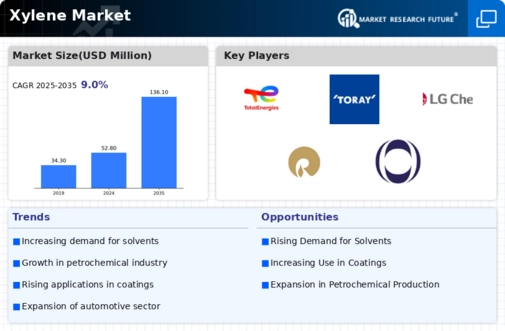Market Trends
Key Emerging Trends in the Xylene Market
The Xylene market is subject to a multitude of dynamic forces that shape its landscape, demand, and pricing. As a key solvent and raw material in various industries such as chemicals, plastics, and pharmaceuticals, the market dynamics of Xylene are complex and influenced by several factors. One significant aspect impacting the Xylene market is its strong correlation with the overall economic health. During periods of economic growth, the demand for Xylene tends to rise as industries expand their production capacities, leading to increased consumption of solvents and raw materials like Xylene. Conversely, during economic downturns, demand may decrease as industries scale back operations to mitigate costs, impacting the market dynamics adversely.
As the xylene market is increasing globally. It has many benefits such as it is used in paint thinners, nail polish and movers glues, and correction fluids. It is also used as an alternative fuel in heavy engines.
Moreover, the Xylene market is also influenced by regional and global supply-demand imbalances. Production capacities, particularly in key manufacturing hubs such as Asia-Pacific and North America, play a crucial role in dictating market dynamics. Any disruptions in the supply chain, whether due to geopolitical tensions, natural disasters, or logistical challenges, can cause fluctuations in Xylene prices and availability. Additionally, regulatory policies and environmental considerations further shape the market dynamics of Xylene. Stringent regulations pertaining to emissions, waste disposal, and occupational safety drive innovation and adoption of cleaner production processes, impacting both supply and demand dynamics of Xylene.
Furthermore, technological advancements and shifting consumer preferences contribute to the evolving landscape of the Xylene market. Continuous research and development efforts lead to the discovery of alternative solvents and production methods, posing both opportunities and challenges for the traditional Xylene market. Additionally, growing awareness about environmental sustainability and health concerns drive the demand for eco-friendly solvents, prompting manufacturers to explore greener alternatives and adapt their strategies accordingly.
The competitive landscape also plays a crucial role in shaping the dynamics of the Xylene market. Key market players constantly engage in strategic initiatives such as mergers and acquisitions, product innovations, and capacity expansions to gain a competitive edge and capture larger market share. Pricing strategies, supply chain optimization, and investment in research and development further influence market dynamics by affecting supply availability and pricing competitiveness.
Moreover, the Xylene market is intricately linked with downstream industries such as paints and coatings, adhesives, and rubber manufacturing. Fluctuations in these industries directly impact the demand for Xylene, thereby affecting its market dynamics. For instance, a surge in construction activities drives the demand for paints and coatings, consequently increasing the need for Xylene as a solvent.
Additionally, market dynamics of Xylene are influenced by shifting trade patterns and geopolitical factors. Trade tensions, tariff policies, and geopolitical instability can disrupt supply chains, leading to market volatility and affecting prices and availability of Xylene. Furthermore, evolving consumer preferences and market trends, such as the growing demand for bio-based solvents and eco-friendly products, are reshaping the competitive landscape and driving innovation in the Xylene market.








Leave a Comment